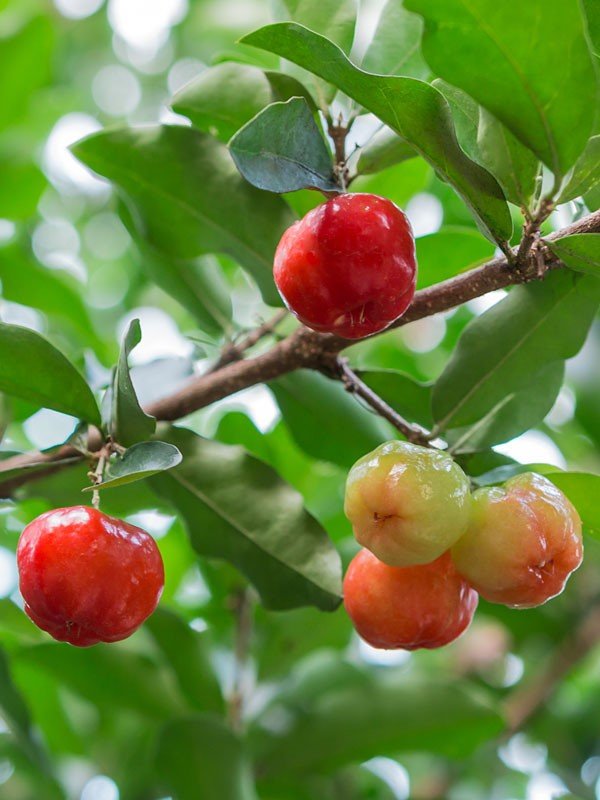Nutrients: The acerola cherry is mostly noted for its high concentration of ascorbic acid (vitamin C). Fresh acerola can contain as much as 3.5% ascorbic acid by weight, and a 180mL glass of fresh squeezed acerola juice can contain as much vitamin C as 14 liters of orange juice! The vitamin C in the acerola cherry also has a higher absorbance into the body than other natural sources. One study found that the bio-availability of vitamin C in acerola is 1.63 times higher than that found in synthetic sources. Acerola is also a source of vitamin C, iron, calcium, phosphorus, and vitamin B, although levels do not typically exceed 10% of your recommended daily allowance.
Anthocyanins: Like other berries found in the Latin America region, the acerola cherry is an excellent source of anthocyanins. Anthocyanins are a type of flavonoid molecule that have been the subject of intense scrutiny by the medical community because of their alleged health benefits. Laboratory based experiments suggest that anthocyanins may help prevent or appease a variety of health ailments including cancer, diabetes, fibrocystic disease, inflammation, bacterial infections, and aging and neurological impairments*.
A study published in the Journal of Agricultural and Food Chemistry studied the anthocyanin concentrations of four amazon berries and found that acerola concentrate contained the chemical backbones of anthocyanin compounds cyanidin, delphinidin, peonidin, pelargonidin, petunidin, and malvidin.
Anti-oxidant activity: Acerola has also demonstrated a high anti-oxidant activity. Anti-oxidants are molecules that prevent the transfer of electrons, which can cause large chain reactions within the cell that can cause damage to enzymes, proteins, lipids, and other biologically important molecules.
A study published in 2006 in the journal Rural Science compared the anti-oxidant capacity of 14 different Amazonian/Latin American berries and found that acerola scored the highest. Another study published in the April, 2004 issue of Phytotherapy Research found that acerola cherry juice extracted in acetone and hexane helped inhibit tumorous cell growth in oral squamous cell carcinoma and human submandibular gland carcinoma cell lines*. Acerola may also improve the anti-oxidant capacity of other nutrients when they are consumed together. For example, a study published in December of 2000 in the Journal of Agricultural and Food Chemistry found that certain soy and alfalfa extracts displayed increased anti-oxidant capacity against LDL cholesterol* when consumed with acerola cherry extract.
Potency: The health benefits of acerola can vary widely depending on the age and state of the fruit when it’s consumed. In general, the younger and fresher the fruit is the more beneficial it will be when consumed. For example, a study published in the journal Food Science and Technology International found that immature acerola had a vitamin C and polyphenol content roughly twice as high as mature acerola. Anti-oxidant capacity in the immature cherry against the molecule methyl linoleate was also double that of the mature fruit. A similar study published in the Journal Plant Foods and Human Nutrition found that unripe acerola had a greater ability to protect DNA from oxidative stress and inhibited the free radical DPHH*.
History: In addition to being eaten, Acerola also has a long history as an ornamental plant. It’s been used in the Japanese practice of bonsai, and in Latin America it’s frequently used to decorate tables, kitchens, and living rooms. The plant typically grows to be 2-5 meters high, and its branches are thin and brittle, making it easy to prune and mold.
It’s believed Acerola first began to grow in southern Mexico, but its cultivation quickly spread into other parts of the Caribbean and Latin America as news of its usefulness spread. Research on the health benefits of Acerola first showed up in the 1940’s from Puerto Rican researchers and continues to this day.






Reviews (0)
There are no reviews yet.